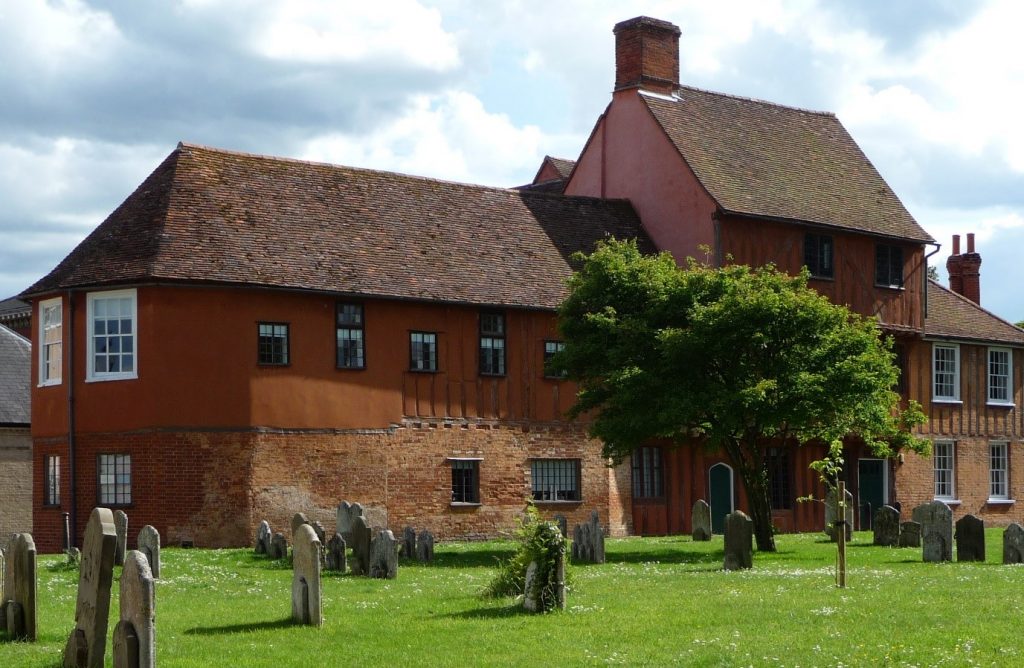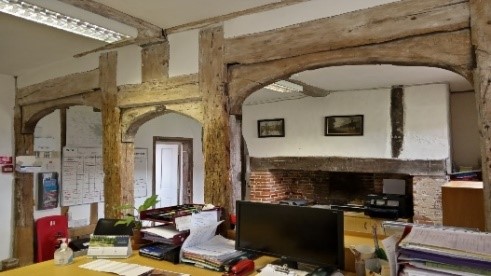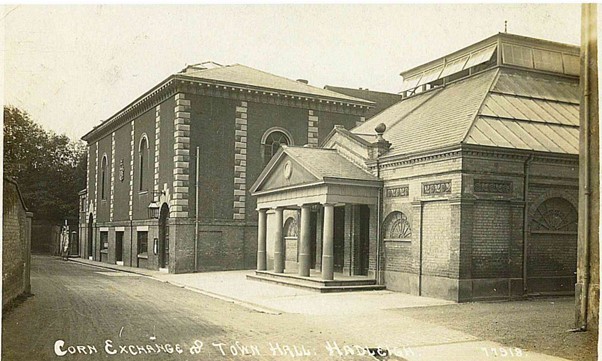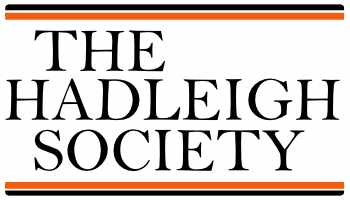Report by Martin Looker
Hadleigh Society’s presentation on 23rd August “The story of Hadleigh Guildhall” created a huge amount of interest. The meeting was attended by around 100 people, including six councillors, two Town Hall Staff and 30 visitors – a capacity crowd!

This magnificent building is deemed to be of exceptional national and international significance and, because of this, the History Group prepared a time-line on the Guildhall, dating from 1252, after researching documents held at Hadleigh, Suffolk, and Canterbury Cathedral archives (*Early medieval manorial records are held at Canterbury because, in the 10th century, the manor of Hadleigh Hall was left to the Church of Christ, predecessor of Canterbury Cathedral).
Many of the early documents were in Latin and had to be translated. Most of the talk was built on these documents, so was very much evidence-based.
| Six members of the History Group delved into different aspects of the site’s fascinating 700-year history.Margaret Woods: Medieval Origins Sally Looker: The Guildhall and Market Hall in the 15th Century Sue Angland: The Workhouse Mark Lawrence: Prosperity and Decline; the 17th and 18th Centuries Sue Angland: Revival in the 19th Century Roger Kennell: The 20th Century |
The subject was highly topical because the future use of the Guildhall is under consideration.
The full time-line is posted on the Hadleigh Society website at https://hadsoc.org.uk/guildhalltimeline/
Here are some highlights from the presentations:
Margaret Woods:
The place and space
Margaret started at the very beginning by looking at the use and boundaries of a piece of ground belonging, in the 13th century, to the ancient Manor of Toppesfield.

Depiction of a medieval market
It can still be identified today, in part surrounded by the tall brick wall built in 1496. “This enclosure currently contains the 18th century manor house standing on the site of the medieval residence, Hadleigh Health Centre, Mill Pharmacy and the associated car parks,” said Margaret.
To the east was an enclosure, known as “Churchcroft” (on which the Guildhall was later built), so named because it was the croft near the Saxon church. In medieval times a croft usually referred to a defined or enclosed area near a house, often used as a meadow, for pasturing animals or growing crops or vegetables, keeping poultry or even as a garden.
Although it is not known how Churchcroft was used it could have been any one of these activities.
Main trading routes from Layham, Dedham, Ardleigh, Langham and Kersey probably passed through and around Churchcroft which had been chosen as the site for a market and annual fair when granted to the Lords of Toppesfield Manor, by Henry III in 1242.
In 1419 Wm Clopton, the then Lord “granted Churchcroft, along with the market and market rights to six Hadleigh men”. The annual rent was 6s 6d or half a mark!
By 1433, a deed records for the first time “a long house newly constructed beside the churchyard called ‘le Markethouse’ with chambers existing underneath…….called Almshouses”.
This marked the first stage of Churchcroft and subsequent buildings becoming Hadleigh’s civic centre “for the use of the town’s inhabitants and also for the governance of the town”.
Sally Looker:
Building on cloth prosperity
By the middle of the fifteenth century the town had become a major cloth manufacturing centre. An elite group of wealthy individuals, “chief inhabitants”, who governed the town, had the means to spend lavishly on the Guildhall and new Market Hall.

Evidence of medieval shopfronts in the Market Hall, currently used as council offices.
Two small deeds at the Suffolk Archives gave documentary evidence. The first, dated 1449, relates to a parcel of land on Churchcroft giving dimensions believed to fit the footprint of the guildhall site.
The second in 1451, marks another transfer of property from one group of feoffees (trustees) to another and includes the first reference to the Market Hall.
The buildings were originally separate and had very different functions. The Guildhall had an underlying religious purpose while the Market Hall was a commercial building.
Six religious guilds have been identified. Originally, all guild activities – religious, business and social – took place in the church in Hadleigh, usually accompanied by banqueting and feasting. During the 15th century popular opinion turned against this practice. In Hadleigh this may be one reason why the guilds decided to erect their own, splendid purpose-built building.
A detached brick kitchen is thought to have been built at the same time as the Guildhall, probably to reduce the risk of fire. Its large hearth – the full width of the building – was able to provide amply for the annual guild feasts.
Both the Guildhall and Market Hall share impressive timber framing. Trading was carried on within the Market Hall and, interestingly, evidence of the medieval shopfronts can still be seen today
In 1547 all guilds were abolished nationally, their wealth and property confiscated by the Crown. Perhaps to pre-empt this, the Hadleigh guilds decided to sell their goods and the £169 raised was used to purchase land to provide regular income to support the poor.
Around 1591 Elizabeth I sold the building to private owners. Two years later four Hadleigh men claimed it back arguing that the premises had not been used exclusively by the guilds. Independent arbitrators decided in the favour of the town and the whole building came into possession of the town.
Sue Angland:
Workhouse established
With the guilds gone and the Guildhall brought back into the possession of the town in 1573, a workhouse – initially called a ‘House of Correction’ – was installed. It was agreed by the feoffees in 1574 that a fit man and his wife should dwell in the “towne house” to be responsible for the workhouse. Discipline and occupational skills were to be taught.
By 1589 the Market Feoffment was responsible for the maintenance of the workhouse and the town’s clothiers promised that, from time-to-time, work would be provided for the inmates.
In 1779 the workhouse was identified as being suitable for 100 inmates, though it is not known whether it was run at full capacity. “But we do know there were 40 bedsteads, 40 dishes and 48 wooden spoons!” reported Sue.
The workhouse operated from the Guildhall for 250 years. The poor of Hadleigh were looked after comparatively well. They were employed in spinning and combing for the cloth industry. They ate beef and mutton and the children received two hours schooling a day.
As a result of the Poor Law Amendment in 1834, Hadleigh had to close its own long-established workhouse at the Guildhall and, instead, the poor were sent to the Cosford Union workhouse in Semer.
Mark Lawrence:
The town’s ups and downs
After several attempts the “chief inhabitants” (referred to earlier) were finally successful in gaining a royal charter of incorporation from James I, achieving borough status in 1618. This wasn’t just to increase the status of Hadleigh but the formalisation of self-government was an essential means to deal with the challenges created by an increasing population and a rise in migration into the town.
Much of the administration centred on the Guildhall set of buildings and one of the rooms was refurbished, including locks and iron bars to the Council chamber to safeguard the charter and recently-acquired silverware.

However, after 75 years of self-governance, Charles II began a process of revoking the charters and re-granting them in a form that gave the King more control.
Hadleigh lost its charter. Governance was passed to the vestry, made up of the Dean of St Mary’s, the churchwardens, overseers of the poor and a select group of parishioners, who initially were the same people who ran the town as the Corporation.
By the 17th century the cloth trade was in decline. Civil wars and revolution had a significant impact on trade, as did improved means of transport and changes in customer taste. The rise of the north of England with its coal, iron and abundance of water, facilitating the operation of machinery, contributed to the near collapse of the cloth trade.
This decline was mirrored in the fortunes of the Feoffment charities – which fell from the prosperity of the early 1600s to mounting debts a little over 100 years later.
In 1792 the top story of the Market Hall (facing the churchyard) collapsed and was removed. The timber-framed north wall had also fallen into decay and its jetty was underbuilt with brick. The Market Hall was extended and an assembly room, today’s Council Chamber) was created on the first floor. Today’s archive is on the ground floor. This work left the Feoffment £123 5s in debt!
Sue Angland:
Revival!
The 19th Century was a time of great revival in the fortunes of the town. The new Corn Exchange was built on land belonging to the Market Feoffment, the independent chapel was built in the Market Place. The look of the town changed, particularly in the High Street. Brick frontages were installed on buildings to cover the timber frames. The silk mill was built, schools were opened…… and the railway came to Hadleigh.
The Market Place was further transformed.
In 1851 the feoffees paid John Nunn of Whatfield and William Clarke, builder of Hadleigh to erect a new Town Hall, near the Corn exchange, for £840. It was designed in the Italianate style and was to be used for public events. Part, though it is not clear how much, of the southern end of the Guildhall was demolished in the process.

New Town Hall (left) built in 1851, part of the Guildhall complex.
A two-day fancy bazaar was held in 1858 in the New Town Hall to raise money for St Mary’s Church. The event was recorded in the London Illustrated News. It was certainly a prosperous time for the town of Hadleigh!
Roger Kennell:
Supporting America!
Corsets were made in the Old Town Hall. William Pretty & Son of Ipswich secured a contract “as the sole maker for Europe and the Colonies” for North America’s largest corset manufacturing business, Warner Brothers. This major contract required an expansion of capacity while a new and larger factory was being built in Ipswich. The Hadleigh premises, known as the ‘stay factory’ opened in 1901, for which the Feoffment Charity charged an annual rent of £30, employed 100 girls.
The Guildhall complex and the Hadleigh Urban District Council, with both their peacetime responsibilities and their considerable additional wartime requirements, made the Guildhall the focus of running the town during those dark days of World Wars.
During WWI troops were in the town and, as the military were proposing to billet a further 450, the Town Hall itself, as well as other places, was used for accommodation.
In WWII the fire engine was housed in the Guildhall and there were two tall telegraph poles with a pulley rope positioned to enable the hoses to be hoisted up and dried. A wall of sandbags was built to protect the engine from potential bomb blast.

The fire station, located at the eastern end of the Guildhall, protected by sandbags in WWII
The Guildroom, which was used by the parish church as a meeting hall, was, at the outbreak of WWII, made available by the rector, Dean Downs, on most evenings to the soldiers quartered in the town for rest and recreation. The room above, the Old Town Hall, was used from October 1939 as a canteen. Dean Downs was then made the Officiating Chaplain for all these soldiers.

